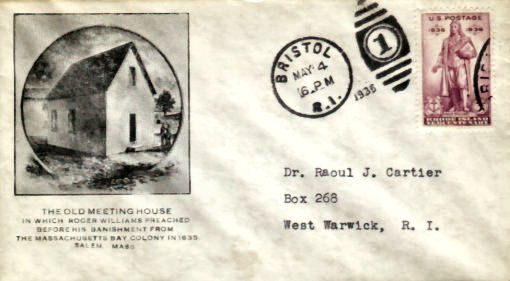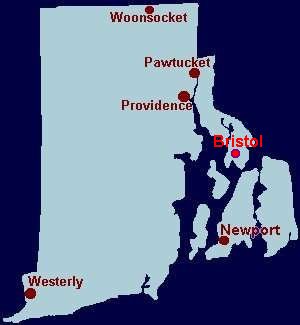![]()
Postal History Introduction
Stampless
Covers
1846
to 1900 Issues
1901-1950
Issues
1951-2003
Issues
Cancels
&
Miscellaneous
Postal
Stationery
Post
Cards
Air
Mail
First
Day &
Event Covers
Parcel Post/Special Delivery
Registered & Official Mail
Commercial & Advertising
Revenue & Postage Due
Wildlife & Game Issues
Complete List of RI Issues
|
Rhode Island Tercentenary Issue
First Day Cover |
|
|
|
|
Unofficial Town Cancel - Bristol,
RI |
|
|
The first official records for the Bristol Post Office date from July 31, 1792. It is probable that this post office was actually established somewhat earlier than this date. The first postmaster of which there is official record was Hezekiak Usher. The Post Office is still in operation. Bristol is the county seat for Bristol County in eastern Rhode Island and is located in the township of Bristol. The township includes the villages of Bristol and Beach Terrace. It is situated on a peninsula between Narragansett Bay and Mount Hope Bay, approximately 13 miles southeast of Providence. It is connected to Aquidneck (Newport) Island to the south by the Mount Hope Bridge. Bristol had a total population of 22,470 in 2000. The earliest references to the area indicate that Sowamsett, (The Native American name for the peninsular) was the favorite abiding place of Massasoit, Chief of the Wampanoag Tribe. The first English settlement in the area was a trading post at Massasoit Springs, (located in present day Warren). Bristol was incorporated in 1681 by the Plymouth colony from land acquired in 1676 near the end of King Phillip's (Metacom) War, (1675-76) and was named after Bristol, England. Bristol was under the jurisdiction of Massachusetts until 1747, when it was annexed by Rhode Island. During the American Revolution it was attacked by the British and partially destroyed on October 7, 1775 and again on May 25, 1778. Bristol Harbor was an active center of Privateering and the Triangular Trade, (rum, molasses and slaves) during the 17th, 18th and early 19th centuries. One of Bristol's most notorious slave traders was James D'Wolf who founded a family shipping firm that was heavily engaged in the slave trade. From 1825 to 1845 the whaling fishery flourished in Bristol and at one time there were 34 vessels engaged in the trade, however by 1850 the trade had been wholly abandoned. The Herreshoff Boatyard was located in Bristol Harbor until it closed in 1945. They were the shipbuilders for eight successful America's Cup defenders. Today Bristol Harbor is mostly in use by pleasure craft. Colonial landmarks include the Joseph Reynolds House, headquarters of General Lafayette in 1778; the Bosworth House, oldest house in Bristol (built in 1680); and the Deputy-Governor Bradford House, (circa 1760). American Indian and Eskimo artifacts are displayed at the Haffenreffer Museum of Anthropology founded in 1955. Bristol's annual Fourth of July parade is thought to be the oldest in the country. It was first observed in the year 1785. |
|
|
Source: Rhode Island Postal History: The Post Offices - Merolla, Jackson & Crowther |
![]()
RI Historical
Society
The Post Offices
Home Page
RI Tercentenary Issue History
RI Philatelic Society
Recently Added Pages
Philatelic Primer
Rhode Island Around the World
Rhode Island
Town Postmarks
Other Websites of Interest

